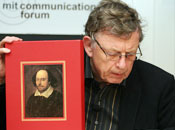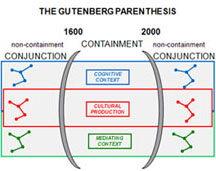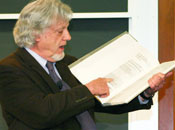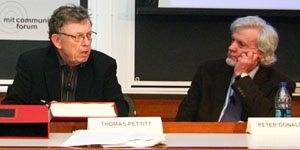| The Gutenberg Parenthesis: Oral Tradition and Digital Technologies | ||||
|
Is our emerging digital culture partly a return to practices and ways of thinking that were central to human societies before the advent of the printing press? This question has been posed with increasing force in recent years by anthropologists, folklorists, historians and literary scholars, among them Thomas Pettitt, who has contributed significantly to elaborating and communicating the version of this question named in the title of today's forum (Pettitt at MIT). Co-sponsor: Writing and Humanistic Studies AudiocastAn audio recording of The Gutenberg Parenthesis is available. Podcast A downloadable podcast of The Gutenberg Parenthesis is available. Video Video of The Gutenberg Parenthesis is available. Summary
Thomas Pettitt explained the way in which he uses the term the Gutenberg Parenthesis: the idea that oral culture was in a way interrupted by Gutenberg's invention of the printing press and the roughly 500 years of print dominance; a dominance now being challenged in many ways by digital culture and the orality it embraces. This new revolution started in the 20th century with sound recording and film, moved next to television and radio and today takes the form of the internet. He points out that there is a common theme when people consider these changes – that they are not simply something new but also the end of something old. Today, Pettitt sees these changes as a challenge to print and the book. For Pettitt, any discussion of the end of the book brings to mind the beginning of the book. He cited Peter L. Shillingsburg's From Gutenberg to Google and suggested that we are at the dawn of a new textual revolution that will be as important as the one started by movable type in the 15th century. In this ongoing communications revolution, Pettitt sees three phases. The first is low-level technology that limits communication to face-to-face interaction with some writing; next is the step up to printing with Gutenberg – which he considers an intermediary technology; and now the Google revolution to a higher technology. Pettitt thinks that studying past phases will allow a better understanding of where we are today and, conversely, that by studying Google we will have new ways to understand Gutenberg. It is interesting, Pettitt thinks, that many scholars are looking forward and seeing the past; that we are on the brink of a second orality based on a return of fluidity in communication. The natural flow of communication was interrupted by the print phase. Pettitt pointed out that the parenthesis does not begin or end at any single point in time. Various cultures and subcultures entered and exited the parenthesis independently.
Pettitt next moved to discuss the actual characteristics of the parenthesis. The primary impact on the mediated context of content during the parenthetical period is containment. Look at a printed work, Pettitt suggested, and you will see strict regimentation. Words are forced into lines, surrounded by margins, placed on pages that are sewn into a binding, contained by a jacket and placed on a shelf where they can be contained and controlled. The words have been "imprisoned" and have lost much of their pre-parenthetical fluidity. This confinement of cultural production has obviously not been limited to the written work: plays move to stages and music to concert halls during the parenthesis. Pettitt sees a similar containment in the realm of cultural production. This is demonstrated by the rise of the individual work and the assumption that a work will have a beginning, middle and end. That a work will be a complete thing and will not be merely fragments; and that once it is complete it will become isolated and static – moving through time with little if any change. Before and after the parenthesis, change and interference of communication are normal. The final containtment – one of cognition according to Pettitt – concerns how we view the world and organize information. During the parenthesis the world was viewed in terms of categories. People were viewed by race and gender. Taxonomies were created to organize things. Everything was contained and described and put into its appropriate category. That wasn't always the case. Now, Pettitt believes, the internet represents a closing of the parenthesis and a return to older models of content, cultural production and understanding. He said that human consciousness in the digital age, which de-emphasizes the kinds of categorization that marked the age of print, makes us think in a way that is reminiscent of a "medieval peasant." Following Pettitt's remarks, Peter Donaldson responded by saying even the exaggerations in Pettitt's presentation were helpful for understanding how totalizing regimes such as the book impact creativity. But, he said, books are more than engines for compressing and restricting meaning.
The collected works of Shakespeare, explained Donaldson, fed the concept of authority that is part of the parenthesis. This is because it was a work with a unitary meaning and an authorized and final form. Of course, Donaldson pointed out, there are issues with this idea of a locked final form, the primary one being variations in text. Half of Shakespeare's plays have some degree of variation – often nominal but variations nevertheless. For example, “To be or not to be, that is the question,” one of the most famous lines, also appeared as “To be or not to be, aye, there's the point.” A change, Donaldson pointed out, that transformed the line from a question to a statement. Scholars don't always know when or why these changes were made – or even if the changes represent additions or omissions of the original work. The attempt to lock down Shakespeare's words illustrates the parenthetic ideas that Pettitt presented. Another issue for Donaldson is the question of performance. Shakespeare was a man of the theater – coming to Stratford-on-Avon originally as an actor. In the theater, variation is unavoidable since productions vary from one day to the next. These variations happen and this is something that needs to be acknowledged. In fact, Donaldson directs the Shakespeare Electronic Archive which uses digital technology to compare various texts and identify differences. Another point by Donaldson was that there have been and will continue to be other parentheses – hypertext and Google for example – that attempt to contain and control content. But at the end of the day, he said, there is no way confinement can work. There will always be content beyond the boundaries of the parenthesis. Audience Discussion Question: This concept is interesting. I like that older oral cultures can tell us something new about today. What is going to come after the parenthesis? Print brought permanence and mobility. The next step is mobility and multiplicity. How can the sense of orality, the medieval peasant and the parenthesis help us understand media today? Pettitt: There's a phrase I should have used in the presentation: "The post-parenthetical period is a reversion to the pre-parenthetical period at a higher level of technology." There will be aspects of the post-parenthetical period that will take print to a higher level. The technology, though, is undermining other aspects of print such as permanence and stability. It isn't just a question of pre-print orality coming back. Text will remain but it is being set free. Text may well become more mobile but less stable as it becomes freer. Donaldson: I don't know much about ballads and broadsides but I can refer people to the work of Tiffany Stern at Oxford on ephemeral paper in Shakespeare's time. She describes a world awash in paper, unlawful paper, unregulated paper, fraudulent paper. James Paradis, moderator: The idea that we are moving to a post-literate society is hard to understand. Much of the post-parenthetical world is highly literate – people are constantly writing and communicating. The idea that we are somehow returning to a preliterate society needs to be modified in some ways. It's not either/ or, it's both/ and. What we're actually merging is a secondary orality that's being supported by a super literacy. The idea of the parenthesis – that we are now returning to something that was before – is not exactly what's happening. Pettitt: The answer is in what you said. The users of the new media are super literate. They are all writing. During the parenthesis there were few writers and many readers. In the new age, you can't really tell the difference between a reader and a writer. We are reproducing the fluidity of orality in text today. With regard to the parenthesis itself – it's certainly provocative. It's better than dashes or a series of dots because it insists on a return to the original thought. We're not going backwards but are resuming where we left off. Question: Parenthesis doesn't seem to be the right term. For example, the Middle Ages were very big on hierarchy; while the internet, if anything, is very flat. The difference between production and consumption – in oral tradition you had to have production everywhere. Today, if I want to see something, I can just look on YouTube. The fact that many more people can produce doesn't mean they have to produce. And, you can consume today with so many more choices. Pettitt: I see what you are saying as compatible with the parenthesis – if we accept that it is made up of several calibrated or broad fuzzy parentheses. Some forms of commentary on text take us back not only to the era of speech but also to the manuscript era. With speech it's difficult to tell the difference between the voice of authority and the interrupt. With writing that becomes much easier. Question: One of the things I kept thinking – almost from the beginning of your presentation – is that I didn't recognize, in early modern books, the kinds of books you were talking about: the autonomous, the enclosed, the bordered. What I am familiar with from that period are compilations put together by editors. They were often “hypertexted” to things outside the book by annotations by the editor and/ or by readers. They don't look like networks because we have lost touch with the original local context. It makes me distrust the larger narrative of the parenthesis as an interruption. You've seemed to distance yourself from that idea as well, saying it's more mobile and people come in and out of it, etc. It strikes me that digital technology has reactivated certain lost potential from the Gutenberg Age. Pettitt: You say early modern books? Is it a transitional type of book that continued into later centuries? There is something gradual about the Parenthesis as its impact is felt. I like what has been said about digital technology and the way it's helping us see and understand things we couldn't in the past. When I have been discussing contained books, I've been thinking of books like this one [holding up a volume of Shakespeare's works]. This is what they did to Shakespeare's plays – originally fragmented, fluid, living things – now imprisoned in this book. This is the fetishization of Shakespeare. His living world now becomes a thing that people can relate to in non-textual ways.
Question: I tend to be dubious about the use of the parenthesis. It seems forced and a little artificial. There was more continuity in the forces that came before and after. It also seems that one form of media doesn't replace another – they tend to be additive. Books will continue. How would you represent what comes after the parenthesis and how it was impacted by what happened during the parenthesis? Pettitt: I think the parenthesis itself implies the impact. Sentences are changed by the presence of a parenthesis. It's a reversion or a carrying on of where we were before – but at a higher level of technology. I need some way to show change and time more effectively in the parenthesis metaphor. You're also right about what's new being additive to the media rather than replacing what existed in the past. Print itself comes on top of written books. Functionally these two types of books are essentially the same but there are so many more printed books. Whatever a written book did a printed book magnified. Prepared by Greg Peverill-Conti and Brad Seawell. Photos by Greg Peverill-Conti. |
||||




